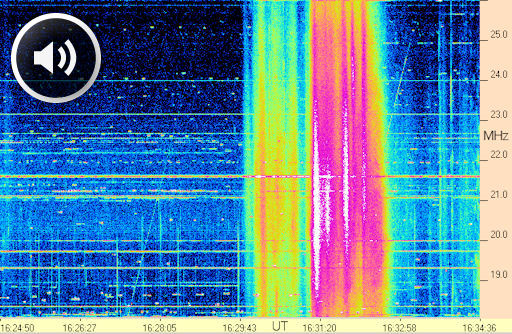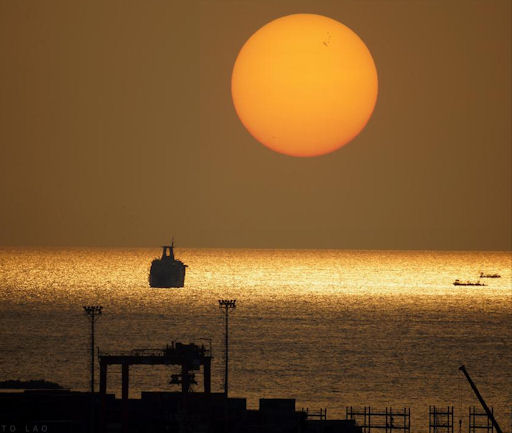Listen to radar echoes from satellites and meteors, live on listener-supported Space Weather Radio. | | |
SOLAR ACTIVITY INTENSIFIES: Huge sunspot AR1476 is crackling with M-class solar flares and appears to be on the verge of producing something even stronger. The sunspot's 'beta-gamma-delta' magnetic field harbors energy for X-class flares, the most powerful kind. Earth is entering the line of fire as the sunspot rotates across the face of the sun. Solar flare alerts: text, phone.
Earlier today, amateur astronomer Thomas Ashcraft of New Mexico detected strong shortwave radio bursts coming from the sunspot. Click to hear the "solar static" that roared out of his loudspeaker:

Dynamic spectrum courtesy of Wes Greenman, Alachua Radio Observatory
"The strongest burst so far occured around 1631 UT on May 9th," reports Ashcraft. "I am observing at 28 MHz and 21.1 MHz. As I send this note I am hearing more bursting, indicating powerful magnetic dynamism within active region 1476."
Solar radio bursts are caused by plasma instabilities that ripple through the sun's atmosphere in the aftermath of powerful flares. With AR1476 poised for more eruptions, this 'radio activity' is likely to continue for days. Stay tuned.
NORTHERN LIGHTS: A solar wind stream hit Earth's magnetic field during the late hours of May 8th, stirring geomagnetic activity and auroras at high latitudes. Zoltan Kenwell photographed the display from a dark-sky site 120km northeast of Edmonton, Alberta:

"The frogs by the lake were deafening!" says Kenwell. "The show began very slowly around 10:00pm MST and was done around 1:00am MST. Temperatures of +12 deg C made for a very enjoyable night while taking in a splendid display."
A pair of CMEs en route to Earth could add to the effect of the solar wind stream, igniting even brighter auroras during the next 24-48 hours. NOAA forecasters estimate a 40% chance of geomagnetic storms on May 9th.
more images: from Paul Beebe of Upsala, Ontario, Canada; from Bob Conzemius of Bovey, Minnesota; from Olivier Du Tré of Cochrane, Alberta; from Matt Melnyk of Edmonton, Alberta; from Steve Milner of Ft St John, British Columbia; from Katie Woodford of Fort McMurray, Alberta, Canada; from Graeme Whipps of Aberdeenshire, Scotland; from Adrian Maricic of Loch Leven, Fife, Scotland; from Ronan Newman of Charlestown, Co Mayo, Ireland; from Martin McKenna of Mussenden Temple, N. Ireland;
SUNSPOT SUNSET: Sunspot AR1476 is so large, people are noticing it without the aide of a solar telescope. The behemoth appears at sunrise and sunset when the light of the low-hanging sun is occasionally dimmed to human visibility. Alberto Lao sends this picture from Manila, the Phillippines:

"The sky was hazy and a bit cloudy today, [perfect for sunspot photography]," says Lao. "Hoping to get a glimpse of AR 1476, I waited until a few minutes before sunset to try to image the sun. My patience was rewarded."
The sunspot looks a lot like Hawaii, but it is much bigger than any island on Earth. From end to end the sprawling active region stretches ~160,000 km, or a dozen times wider than our entire planet. If you have a sunspot telescope, take a look. The view is magnificent.
Caution: Even when the sun is dimmed by clouds and haze, looking into the glare can damage your eyes. Looking through unfiltered optics is even worse. If you chose to photograph the low sun with a digital camera, please use the camera's LCD screen for pointing. Do not peer through the optical viewfinder.

